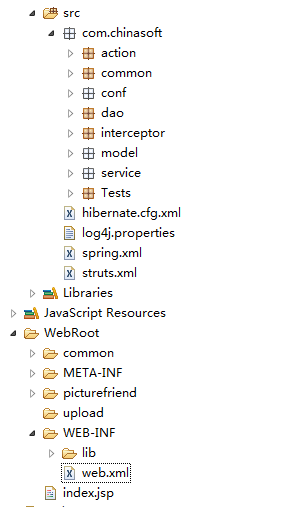如何写一个SSH项目(三)如何进行交互的
下面以登录为例子,展示从前台到后端的一整套流程并进行分析.
首先介绍一下我的SSH的分层结构
- action和service一起是业务逻辑层 action层调用service层
- dao层是数据访问层,也叫做持久层 里面是对数据库的操作
- model是数据库表对应的实体类 我把每个对应的hibernate的配置也写在了这里
- conf包 这里放的是细分的spring和struts的配置文件 一般是一个业务模块一个配置文件
- interceptor包 是我自己定义的拦截器 很多时候struts自带拦截器并不能达到我们的要求
- common包 是自己定义的共用的方法 比如说 定义的常量 工具类
大体的分层就清晰了.

那么我们就上干货吧,直接上代码和分析. 这里只讲流程,不对调用的方法进行涉及.
1.首先是登录界面 logon.jsp
<s:form method="post" target="_parent" namespace="/login" action="loginAction" onsubmit="return checkInfor()"> <div class="login_left"> <h3 class="login_h3">欢迎登录图友网</h3> <div class="login_sr"> 用户名: <!-- <input type="text" class="login_inputYhm"> --> <s:textfield cssClass="login_inputYhm" id="loginName" name="loginName" onfocus="selectText(this)" /> </div> <div class="login_sr"> 密码: <!-- <input type="password" class="login_inputMm"> --> <s:password showPassword="true" cssClass="login_inputMm" id="password" name="password" onfocus="selectText(this)" /> </div> <div class="login_sr"> <div style="float:left">验证码:</div> <!-- <input type="text" name="validateCode" maxlength="4" class="login_inputYzm" style="float:left;"> --> <s:textfield maxLength="4" cssClass="login_inputYzm" style="float:left;" name="validateCode" id="validateCode" value="验证码" onfocus="selectText(this)" /> <div class="login_inputYzmPic" style="float:left"> <img src="<%=basePath%>login/loginAction!findValidateCode" id="validateImage" onclick="refresh()" title="看不清,换一张"> </div> <%-- <span class="login_inputYzmH" onclick="changeCode()">换一张</span> --%> </div> <div> <!-- <button type="submit" value="登录" style="height:30px;width:50px">登录</button> --> <s:submit type="button" cssStyle="height:30px;width:50px" method="login" value="登录"></s:submit> </div> <div class="login_zcymm"> <a href="<%=basePath%>picturefriend/login/register.jsp">注册帐号</a> </div> </div>
点击提交的时候,web.xml中我们配置的struts拦截器会对请求进行拦截,去对应的struts配置文件寻找对应的action处理类,这里可以看到命名空间是/login action是loginAction
method是login.然后会去寻找/login对应的包 这个寻找顺序请自己看我之前的文章
2.struts-login.xml
<?xml version="1.0" encoding="UTF-8"?>
<!DOCTYPE struts PUBLIC "-//Apache Software Foundation//DTD Struts Configuration 2.1//EN"
"http://struts.apache.org/dtds/struts2.1.dtd">
<struts>
<package name="login" namespace="/login" extends="common">
<!-- 这里的common包是在strtus.xml中配置的 就是我们之前自定义的拦截器-->
<action name="loginAction" class="loginAction">
<!-- stream 直接向响应中发送原始数据 通常在用户下载时使用 contentType指定流的类型
contentLength以byte 计算流的长度,
contentDisposition指定文件的位置,通常为 filename=”文件的位置”,
-->
<result name="getValidateCode" type="stream">
<param name="inputName">imageInputStream</param>
<param name="contentType">image/jpeg</param>
</result>
<!-- <result name="result1" type="dispatcher">/picturefriend/main/userIndex.jsp</result>
<result name="result2" type="dispatcher">/picturefriend/main/userIndex.jsp</result> -->
<result name="userSuccess" type="dispatcher">/picturefriend/main/userIndex.jsp</result>
<result name="adminSuccess" type="dispatcher">/picturefriend/main/adminIndex.jsp</result>
<result name="input" type="dispatcher">/picturefriend/login/login.jsp</result>
<result name="logout" type="redirect">/picturefriend/login/login.jsp</result>
</action>
</package>
</struts>
找到了 /login包 然后寻找此包下名为loginAction的action.看到没每一个actionn都有几个result,result是根据业务逻辑返回的字符串去寻找对应的视图
可是为什么这里的class不是一个长长的全名路径是一个字符串呢? 这是因为我们在struts.xml配置了将bean交给了spring去处理,所以我们要根据这个loginAction去Spring找了.
3.applicationContext-action.xml
<bean id="loginAction" class="com.chinasoft.action.login.LoginAction" scope="prototype"> <property name="loginService" ref="loginService"></property> <property name="productSortService" ref="productSortService"></property> </bean>
这里的id就是我们的loginAction class是业务逻辑处理类, property是action处理类的属性,也就是说此action将会用到这两个service类.ref是bean的id.
4.com.chinasoft.action.login.LoginAction.java
因为我们的jsp上对应的方法是login 所以我们只需在业务逻辑类中关注login方法即可.
private LoginService loginService;
public String login() { if (!getSession().get(Constant.SESSION_VALIDATE).toString() .equalsIgnoreCase(validateCode)) { getRequest().put("state", "2"); return INPUT; } //根据输入用户,查询User表 SysUser user = loginService.findUserByLoginName(loginName); if (user != null) {// 根据用户名可以检索到用户信息 System.out.println("用户表中有该用户!"); return judgeUser(user); } else {// 用户表中没有输入的帐号 return judgeAdmin(); } }
此处我们看到会调用loginService,循环上面的步骤
5.ApplicationContext-service.xml
<bean id="loginService" class="com.chinasoft.service.login.LoginServiceImpl" scope="singleton"> <property name="userDao" ref="userDao"></property> <property name="loginDao" ref="loginDao"></property> </bean>
6.com.chinasoft.service.login.LoginServiceImpl
此处注意的是servie层开始面向接口编程,一个接口,一个实现类.我们调用的都是实现类
public SysUser findUserByLoginName(String pLoginName) { try { System.out.println("1111111"); return userDao.findUserByLoginName(pLoginName); } catch (DataAccessException e) { e.printStackTrace(); throw new BusinessException("出现系统错误,请与管理员联系",e); } }
7.ApplicationContext-dao.xml
<bean id="userDao" class="com.chinasoft.dao.user.UserDaoImpl" scope="singleton"> <property name="hibernateTemplate" ref="hibernateTemplate"></property> </bean>
8.com.chinasoft.dao.user.UserDaoImpl.java
public SysUser findUserByLoginName(String ploginName) { String hql = "from SysUser where loginName = ?"; List<SysUser> users = getHibernateTemplate().find(hql, ploginName); if (users.isEmpty()) { return null; } else { System.out.println("user根据用户名查询普通用户信息成功!"); return users.get(0); } }
这里就到了查表了,但是我们实体类是怎么和表对应的啊? 我们用的是hibernate,这个ORM很强大,真的很强大. 我这么配置的
9.SysUser.hbm.xml
<!DOCTYPE hibernate-mapping PUBLIC
"-//Hibernate/Hibernate Mapping DTD 3.0//EN"
"http://hibernate.sourceforge.net/hibernate-mapping-3.0.dtd">
<hibernate-mapping>
<!-- class的name是实体类 table是表名 dynamic-insert,dynamic-update是说和表进行比较 只改变被改变的值,未变动的值不做处理-->
<class name="com.chinasoft.model.user.SysUser" table="SYS_USER" dynamic-insert="true" dynamic-update="true">
<!-- id是主键 name是对应的实体类的属性 column对应表中的字段 generator是设置主键增长方式-->
<id name="userId" column="USER_ID">
<generator class="sequence">
<param name="sequence">SEQ_SYS_USER</param>
</generator>
</id>
<!-- property是其他属性与表对应的固定方式 name属性 column表的字段 type 表中字段类型-->
<property name="birthday" column="BIRTHDAY" type="date"></property>
<property name="email" column="EMAIL" type="string"></property>
<property name="imageUrl" column="IMAGE_URL" type="string"></property>
<property name="loginName" column="LOGIN_NAME" type="string"></property>
<property name="isMale" column="IS_MALE" type="true_false"></property>
<property name="password" column="PASSWORD" type="string"></property>
<property name="registerTime" column="REGISTER_TIME" type="timestamp"></property>
<property name="userName" column="USER_NAME" type="string"></property>
<property name="isLock" column="IS_LOCK" type="yes_no"></property>
<property name="phoneNum" column="PHONE_NUM" type="string"></property>
<!-- 多对一 永远是在多的一方进行配置-->
<!-- 与职位关联配置 -->
<many-to-one name="sysJob" class="com.chinasoft.model.job.SysJob" column="JOB_ID">
</many-to-one>
<!-- 与登录关联配置 -->
<set name="sysLogin" table="SYS_LOGIN" inverse="true" fetch="select">
<key>
<column name="USER_ID"></column>
</key>
<one-to-many class="com.chinasoft.model.login.SysLogin"/>
</set>
<!-- 与作品表关联-->
<set name="products" table="PRODUCT" inverse="true" fetch="select">
<key>
<column name="CREATE_USER" >
</column>
</key>
<one-to-many class="com.chinasoft.model.product.Product" />
</set>
<!-- 与作品查询表关联-->
<set name="productQuerys" table="PRODUCT_QUERY" inverse="true" fetch="select">
<key>
<column name="USER_ID" >
</column>
</key>
<one-to-many class="com.chinasoft.model.product.ProductQuery" />
</set>
<!-- 与作品评论表关联-->
<set name="porductComments" table="PRODUCT_COMMENT" inverse="true" fetch="select">
<key>
<column name="USER_ID" >
</column>
</key>
<one-to-many class="com.chinasoft.model.comment.ProductComment" />
</set>
<!-- 与作品评论回复表关联-->
<set name="commentReplys" table="COMMENT_REPLY" inverse="true" fetch="select">
<key>
<column name="USER_ID" >
</column>
</key>
<one-to-many class="com.chinasoft.model.reply.CommentReply" />
</set>
</class>
</hibernate-mapping>
然后根据查询结果,action层会返回一个字符串,再去struts-login.xml中寻找对应的结果视图就完成了.
前前后后两周多终于把SSH基本掌握了,恭喜自己!



